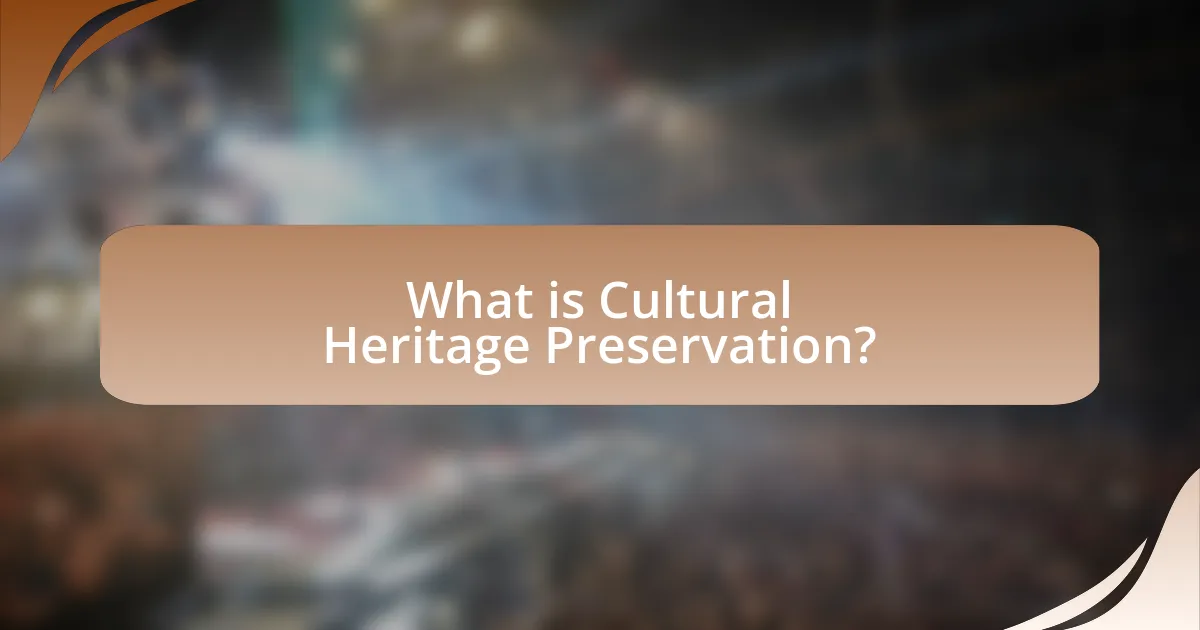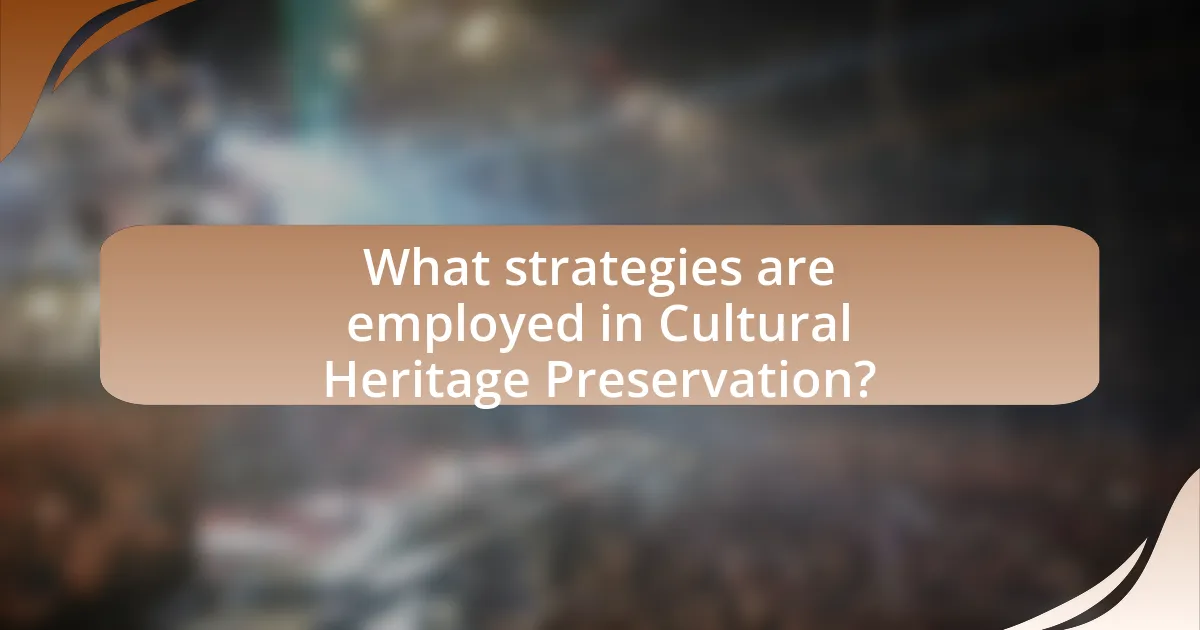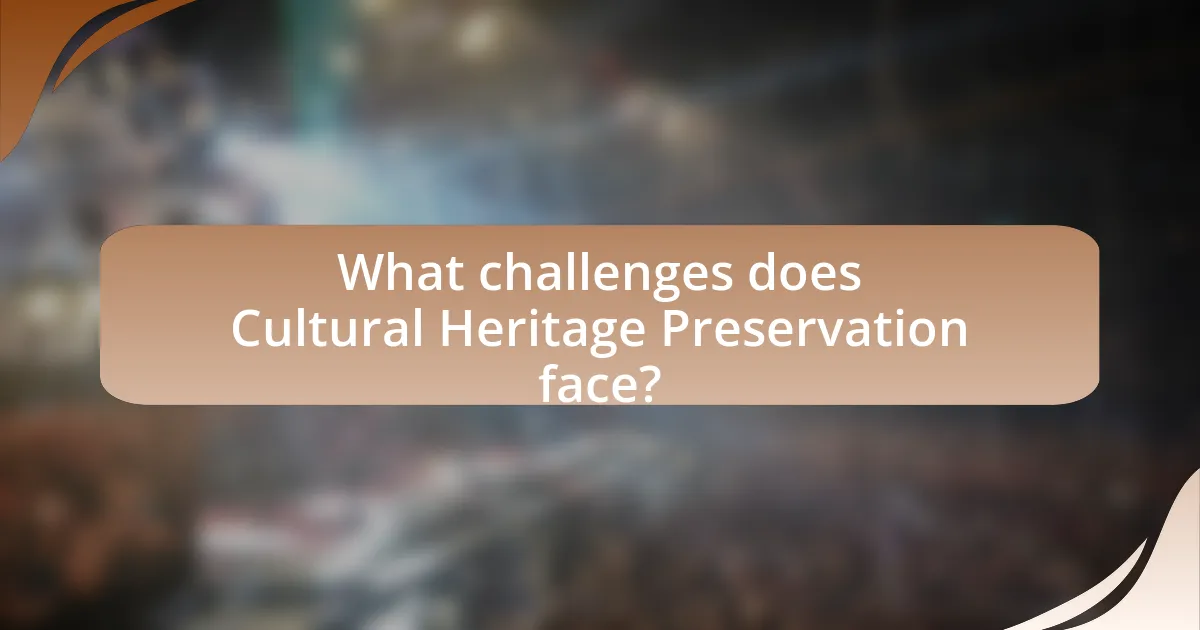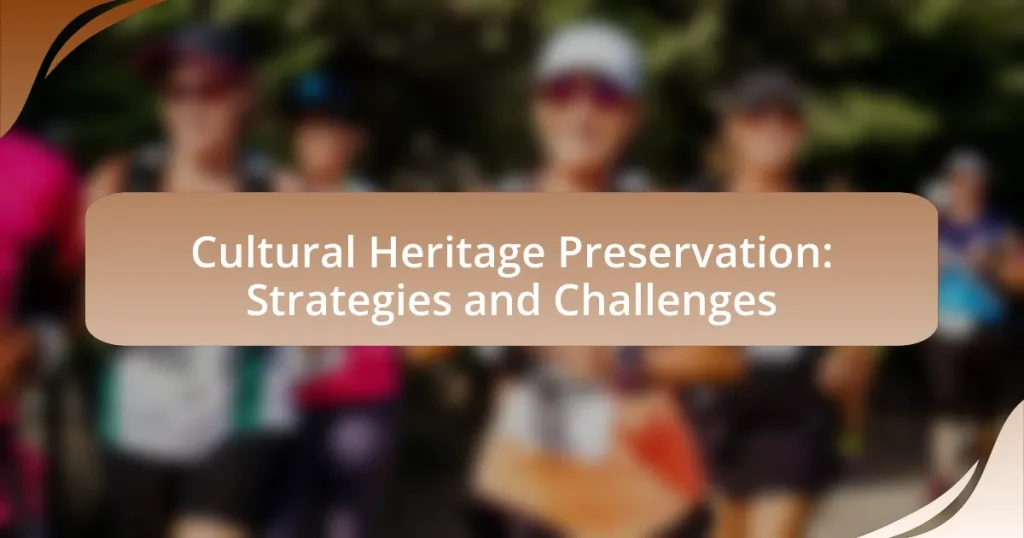Cultural Heritage Preservation refers to the practice of safeguarding both tangible and intangible cultural assets, including monuments, artifacts, traditions, and languages, to maintain cultural identity and historical continuity. This article outlines the importance of cultural heritage preservation, highlighting its role in fostering community identity, promoting diversity, and supporting local economies through tourism. It discusses various types of cultural heritage, key preservation strategies, and the challenges faced, such as urbanization and climate change. Additionally, the article examines the impact of community involvement, technological advancements, and ethical dilemmas in preservation efforts, emphasizing the need for collaborative approaches to enhance outcomes in safeguarding cultural heritage for future generations.

What is Cultural Heritage Preservation?
Cultural Heritage Preservation is the practice of safeguarding and maintaining cultural heritage, which includes tangible and intangible assets such as monuments, artifacts, traditions, and languages. This preservation is essential for sustaining cultural identity and historical continuity, as evidenced by UNESCO’s World Heritage List, which recognizes sites of outstanding cultural significance globally. Effective preservation strategies often involve legal frameworks, community engagement, and conservation techniques to protect these cultural assets from threats like urbanization, climate change, and neglect.
Why is Cultural Heritage Preservation important?
Cultural heritage preservation is important because it safeguards the history, identity, and values of communities. By maintaining historical sites, artifacts, and traditions, societies can foster a sense of belonging and continuity. For instance, UNESCO recognizes over 1,100 World Heritage Sites, which not only highlight cultural significance but also contribute to local economies through tourism. Furthermore, preserving cultural heritage promotes diversity and intercultural dialogue, essential for social cohesion in an increasingly globalized world.
What are the key values associated with cultural heritage?
The key values associated with cultural heritage include identity, continuity, diversity, and education. Identity is reflected in how cultural heritage shapes the sense of belonging and community among individuals. Continuity emphasizes the importance of preserving traditions and practices that connect past generations to the present, fostering a sense of historical awareness. Diversity highlights the richness of different cultures and the need to respect and protect various cultural expressions. Education is crucial as cultural heritage serves as a resource for learning, promoting understanding and appreciation of different cultures. These values are essential for fostering social cohesion and mutual respect in increasingly multicultural societies.
How does cultural heritage contribute to community identity?
Cultural heritage significantly contributes to community identity by providing a shared sense of history, values, and traditions that unite individuals within a community. This shared heritage fosters social cohesion and belonging, as evidenced by the role of traditional festivals and rituals in reinforcing communal bonds. For instance, the celebration of local festivals often reflects historical events or cultural practices unique to the community, thereby enhancing collective identity and pride. Furthermore, studies have shown that communities with strong cultural heritage are more resilient and better able to navigate social changes, as they draw upon their historical narratives to maintain continuity and stability.
What are the main types of cultural heritage?
The main types of cultural heritage are tangible heritage, intangible heritage, and natural heritage. Tangible heritage includes physical artifacts and structures, such as buildings, monuments, and artworks, which are often preserved for their historical and aesthetic value. Intangible heritage encompasses traditions, languages, performing arts, and rituals that are passed down through generations, reflecting the cultural identity of communities. Natural heritage refers to natural sites and landscapes that hold cultural significance, such as national parks and sacred natural sites. These categories are recognized by organizations like UNESCO, which emphasizes their importance in maintaining cultural diversity and identity.
How do tangible and intangible heritage differ?
Tangible heritage refers to physical artifacts and structures, such as buildings, monuments, and artworks, while intangible heritage encompasses non-physical elements like traditions, languages, and performing arts. The distinction lies in the nature of their existence; tangible heritage can be seen and touched, whereas intangible heritage is experienced and transmitted through cultural practices. For example, the Great Wall of China represents tangible heritage, while the traditional Chinese opera exemplifies intangible heritage. This differentiation is crucial for cultural heritage preservation strategies, as each type requires distinct approaches for safeguarding and promoting its significance.
What examples illustrate each type of cultural heritage?
Cultural heritage is categorized into three main types: tangible, intangible, and natural heritage. Tangible heritage includes physical artifacts like the Great Wall of China and the Pyramids of Giza, which are significant historical structures. Intangible heritage encompasses traditions and practices, such as the oral storytelling of Indigenous cultures and the art of Japanese tea ceremonies, which are vital for cultural identity. Natural heritage refers to natural sites and landscapes, exemplified by the Grand Canyon and the Great Barrier Reef, which hold ecological and cultural significance. These examples illustrate the diverse forms of cultural heritage that contribute to our understanding of history and identity.
What are the primary goals of cultural heritage preservation?
The primary goals of cultural heritage preservation are to safeguard and maintain the tangible and intangible aspects of cultural heritage for future generations. This includes protecting historical sites, artifacts, and traditions that embody the identity and values of communities. Preservation efforts aim to ensure that cultural heritage remains accessible and relevant, fostering a sense of belonging and continuity within societies. Additionally, these goals support educational initiatives, promote cultural diversity, and enhance tourism, contributing to economic sustainability.
How does preservation impact future generations?
Preservation impacts future generations by ensuring the continuity of cultural heritage, which fosters identity and community cohesion. When cultural artifacts, traditions, and historical sites are preserved, they provide future generations with a tangible connection to their past, enhancing their understanding of history and cultural diversity. For instance, UNESCO reports that sites like the Great Wall of China and the Pyramids of Giza not only serve as educational resources but also promote tourism, which can economically benefit local communities. This economic support can further enable the preservation of cultural practices and sites, creating a sustainable cycle that benefits both current and future populations.
What role does education play in cultural heritage preservation?
Education plays a crucial role in cultural heritage preservation by fostering awareness and understanding of cultural significance among individuals and communities. Through educational programs, people learn about their cultural history, traditions, and the importance of preserving these elements for future generations. For instance, UNESCO emphasizes that education can empower communities to actively engage in safeguarding their heritage, as seen in various initiatives that integrate local history into school curricula. This approach not only enhances cultural identity but also encourages participation in preservation efforts, thereby ensuring that cultural heritage is maintained and valued over time.

What strategies are employed in Cultural Heritage Preservation?
Cultural heritage preservation employs strategies such as documentation, restoration, conservation, and community engagement. Documentation involves recording the history, significance, and condition of heritage sites, which is essential for informed decision-making. Restoration focuses on returning a site to its original state, using techniques that respect the authenticity of the materials and design. Conservation aims to protect and maintain the integrity of cultural artifacts and structures over time, often involving scientific methods to prevent deterioration. Community engagement fosters local involvement and awareness, ensuring that preservation efforts align with the values and needs of the community. These strategies are supported by international frameworks like the UNESCO World Heritage Convention, which emphasizes the importance of preserving cultural heritage for future generations.
How do governments support cultural heritage preservation?
Governments support cultural heritage preservation through legislation, funding, and international cooperation. Legislation often includes laws that protect historical sites and artifacts, such as the National Historic Preservation Act in the United States, which provides a framework for preserving significant cultural resources. Funding is allocated through grants and programs aimed at restoration and maintenance of heritage sites; for example, UNESCO’s World Heritage Fund assists countries in preserving sites of outstanding universal value. Additionally, governments engage in international cooperation by participating in treaties and conventions, such as the 1972 UNESCO World Heritage Convention, which encourages collaboration among nations to safeguard cultural heritage globally.
What policies are commonly implemented for preservation?
Commonly implemented policies for preservation include legal frameworks, funding mechanisms, and community engagement initiatives. Legal frameworks often consist of national and international laws that protect cultural heritage sites, such as the UNESCO World Heritage Convention, which establishes guidelines for the identification and protection of significant cultural properties. Funding mechanisms, such as grants and tax incentives, provide financial support for preservation projects, enabling the maintenance and restoration of heritage sites. Community engagement initiatives encourage local populations to participate in preservation efforts, fostering a sense of ownership and responsibility towards cultural heritage. These policies collectively aim to safeguard cultural heritage for future generations while promoting awareness and appreciation of historical significance.
How do funding and grants facilitate preservation efforts?
Funding and grants facilitate preservation efforts by providing essential financial resources needed to maintain and restore cultural heritage sites. These financial contributions enable organizations and governments to undertake projects that would otherwise be unaffordable, such as structural repairs, conservation of artifacts, and community engagement initiatives. For instance, the National Park Service in the United States allocates millions of dollars annually through its Historic Preservation Fund, which supports local preservation projects, demonstrating the direct impact of funding on the preservation of historical sites.
What role do communities play in preservation strategies?
Communities play a crucial role in preservation strategies by actively participating in the identification, protection, and promotion of cultural heritage. Their involvement ensures that local knowledge, traditions, and values are integrated into preservation efforts, making them more relevant and effective. For instance, community-led initiatives often lead to the successful safeguarding of heritage sites, as seen in the case of the community-driven preservation of the historic town of Tzintzuntzan in Mexico, where local residents collaborated with authorities to maintain their cultural identity and heritage. This collaboration not only fosters a sense of ownership but also enhances the sustainability of preservation efforts, as communities are more likely to support and engage with initiatives that reflect their cultural significance.
How can local initiatives enhance preservation efforts?
Local initiatives can enhance preservation efforts by fostering community engagement and promoting awareness of cultural heritage. When local communities actively participate in preservation activities, they develop a deeper connection to their cultural assets, which can lead to increased support for preservation initiatives. For example, studies have shown that community-led projects, such as local heritage festivals or educational programs, can significantly raise awareness and appreciation for cultural heritage, resulting in higher volunteerism and funding for preservation efforts. Additionally, local initiatives often tailor their strategies to the specific needs and values of the community, making preservation efforts more relevant and effective.
What are the benefits of community involvement in preservation?
Community involvement in preservation enhances cultural heritage by fostering local ownership, increasing awareness, and ensuring sustainable practices. Engaging community members leads to a deeper connection to their cultural assets, which can result in more effective advocacy and support for preservation efforts. Studies show that when communities actively participate, they are more likely to contribute resources, volunteer time, and share knowledge, which strengthens the preservation initiatives. For instance, the National Trust for Historic Preservation highlights that community-led projects often see higher success rates due to increased local investment and emotional attachment to the heritage being preserved.
What technological advancements aid in cultural heritage preservation?
Technological advancements that aid in cultural heritage preservation include 3D scanning, digital archiving, and virtual reality. 3D scanning allows for the precise documentation of artifacts and sites, creating detailed digital models that can be used for restoration and study. Digital archiving enables the storage of historical documents and images in accessible formats, ensuring their longevity and protection from physical degradation. Virtual reality provides immersive experiences that allow users to explore heritage sites and artifacts remotely, enhancing public engagement and education. These technologies collectively contribute to the safeguarding and dissemination of cultural heritage, as evidenced by projects like the digitization of the British Library’s collection, which has made millions of historical texts available online.
How does digital documentation contribute to preservation?
Digital documentation significantly contributes to preservation by creating accurate, accessible, and durable records of cultural heritage. This method allows for the detailed capture of artifacts, texts, and sites in various formats, such as images, videos, and 3D models, which can be stored and shared widely. For instance, the digitization of the Dead Sea Scrolls has enabled global access to these ancient texts, ensuring their study and appreciation while protecting the originals from deterioration. Furthermore, digital documentation facilitates the replication of cultural heritage items, allowing for educational use and public engagement without risking damage to the originals.
What are the implications of virtual reality in heritage sites?
Virtual reality (VR) significantly enhances the preservation and accessibility of heritage sites by providing immersive experiences that allow users to explore and interact with historical environments. This technology enables virtual reconstructions of sites that may be damaged or inaccessible, thereby preserving cultural heritage for future generations. For instance, the use of VR in the reconstruction of the ancient city of Pompeii allows visitors to experience the site as it was before the eruption of Mount Vesuvius, offering educational insights and fostering a deeper connection to history. Additionally, VR can increase public engagement and awareness of heritage conservation efforts, as seen in projects like the “Virtual Reality Heritage” initiative, which aims to educate users about the importance of preserving cultural sites.

What challenges does Cultural Heritage Preservation face?
Cultural Heritage Preservation faces significant challenges including urbanization, climate change, and insufficient funding. Urbanization leads to the destruction of historical sites as cities expand, often prioritizing development over preservation. Climate change poses threats through natural disasters and environmental degradation, which can damage or destroy cultural artifacts and sites. Additionally, insufficient funding limits the ability of organizations and governments to maintain and restore heritage sites, leading to neglect and deterioration. For instance, UNESCO reports that over 1,000 World Heritage sites are at risk due to these factors, highlighting the urgent need for effective preservation strategies.
What are the major threats to cultural heritage?
The major threats to cultural heritage include natural disasters, armed conflict, urbanization, climate change, and neglect. Natural disasters, such as earthquakes and floods, can cause irreversible damage to historical sites, as seen in the 2010 earthquake in Haiti that devastated numerous cultural landmarks. Armed conflict often leads to the deliberate destruction of heritage, exemplified by the destruction of the Buddhas of Bamiyan in Afghanistan in 2001. Urbanization poses a threat through the encroachment of modern development on historical sites, leading to their degradation or complete loss. Climate change exacerbates these threats by increasing the frequency of extreme weather events and rising sea levels, which endanger coastal heritage sites. Lastly, neglect and lack of funding for maintenance can result in deterioration, as observed in many underfunded museums and heritage sites worldwide.
How do natural disasters impact cultural heritage sites?
Natural disasters significantly damage cultural heritage sites by causing physical destruction, loss of artifacts, and disruption of historical narratives. For instance, earthquakes can collapse structures like temples and monuments, while floods can erode foundations and wash away archaeological sites. The 2010 earthquake in Haiti destroyed the National Palace and severely damaged the historic city of Jacmel, illustrating the vulnerability of cultural heritage to such events. Additionally, natural disasters can lead to the loss of intangible cultural heritage, such as traditional practices and community knowledge, as communities are displaced and their cultural continuity is interrupted.
What role does urbanization play in heritage loss?
Urbanization significantly contributes to heritage loss by facilitating the demolition of historical sites to make way for new developments. As cities expand, the demand for land often leads to the destruction of culturally significant structures, which are frequently viewed as obstacles to modernization. For instance, UNESCO reports that urban sprawl has resulted in the loss of numerous heritage sites worldwide, with cities like Istanbul and Cairo experiencing substantial declines in their historical architecture due to rapid urban development. This trend not only erases physical landmarks but also diminishes the cultural identity and historical narratives associated with these sites, further exacerbating the challenge of preserving cultural heritage in urban environments.
How do political and social factors affect preservation efforts?
Political and social factors significantly influence preservation efforts by determining funding, policy priorities, and community engagement. Governments often allocate resources based on political agendas, which can either support or hinder preservation initiatives; for instance, in countries where cultural heritage is prioritized, such as Italy, substantial funding is directed towards restoration projects. Social factors, including public awareness and community involvement, also play a crucial role; communities that actively engage in preservation efforts tend to see more successful outcomes, as evidenced by grassroots movements in places like New Orleans, where local organizations have successfully advocated for the protection of historic neighborhoods.
What challenges arise from conflicts and wars regarding heritage?
Conflicts and wars pose significant challenges to heritage preservation, primarily through the destruction of cultural sites and artifacts. Armed conflicts often lead to deliberate targeting of heritage sites, as seen in the destruction of the Buddhas of Bamiyan in Afghanistan in 2001 by the Taliban, which exemplifies the loss of irreplaceable cultural symbols. Additionally, the looting of museums and archaeological sites during conflicts, such as the Iraq War, results in the permanent loss of historical artifacts and knowledge. Furthermore, the displacement of communities disrupts traditional practices and the transmission of cultural heritage, undermining the continuity of cultural identity. These challenges highlight the urgent need for effective strategies to protect heritage during times of conflict.
How can cultural appropriation hinder preservation efforts?
Cultural appropriation can hinder preservation efforts by commodifying and misrepresenting cultural elements, which undermines the authenticity and significance of those cultures. When dominant cultures adopt aspects of marginalized cultures without understanding or respecting their context, it can lead to a dilution of cultural practices and traditions. For instance, the commercialization of Indigenous art forms often strips them of their original meanings and spiritual significance, making it difficult for Indigenous communities to maintain their cultural heritage. This misrepresentation can also result in a lack of support for genuine preservation initiatives, as resources may be diverted towards appropriated versions rather than authentic cultural expressions.
What are the ethical dilemmas in cultural heritage preservation?
Ethical dilemmas in cultural heritage preservation include the conflict between conservation and development, the ownership and repatriation of artifacts, and the representation of diverse cultural narratives. These dilemmas arise when the need to protect cultural sites and artifacts clashes with economic interests, such as tourism or urban development, which can lead to irreversible damage. For instance, the construction of infrastructure projects often threatens archaeological sites, raising questions about prioritizing cultural integrity over economic growth. Additionally, the debate over the rightful ownership of cultural artifacts, particularly those taken during colonial periods, poses ethical challenges regarding restitution and the acknowledgment of historical injustices. Furthermore, the representation of cultural narratives can be contentious, as certain groups may feel marginalized or misrepresented in the preservation process, leading to conflicts over whose history is valued and preserved. These ethical dilemmas highlight the complexities involved in balancing cultural heritage preservation with contemporary societal needs and values.
How do differing cultural perspectives influence preservation decisions?
Differing cultural perspectives significantly influence preservation decisions by shaping the values and priorities assigned to cultural heritage. For instance, Indigenous communities often prioritize the preservation of sites that hold spiritual significance, while Western perspectives may focus on historical or aesthetic values. This divergence can lead to conflicts over which sites are deemed worthy of protection, as seen in cases like the Standing Rock protests, where Native American tribes sought to protect sacred lands from pipeline construction, contrasting with governmental and corporate interests in economic development. Such examples illustrate how cultural values directly impact the decision-making processes surrounding preservation, highlighting the need for inclusive approaches that respect diverse viewpoints.
What are the implications of commercialization on heritage sites?
Commercialization of heritage sites often leads to both positive and negative implications. On one hand, it can generate significant revenue that supports maintenance and preservation efforts; for example, UNESCO reported that heritage tourism contributes billions to local economies. On the other hand, commercialization can result in the commodification of cultural heritage, leading to the erosion of authenticity and cultural significance. Studies have shown that excessive commercialization can diminish the visitor experience and alter the site’s historical context, as seen in places like Venice, where tourism has transformed local culture and daily life. Thus, while commercialization can provide financial benefits, it poses risks to the integrity and preservation of heritage sites.
What best practices can enhance Cultural Heritage Preservation?
Best practices that can enhance Cultural Heritage Preservation include community engagement, documentation, and sustainable tourism. Community engagement fosters local ownership and stewardship, ensuring that cultural practices and knowledge are passed down through generations. Documentation, such as creating detailed records and inventories of cultural assets, helps safeguard against loss and provides a basis for future conservation efforts. Sustainable tourism practices minimize environmental impact and promote awareness, allowing visitors to appreciate cultural heritage without compromising its integrity. These practices are supported by various studies, including the UNESCO guidelines on cultural heritage management, which emphasize the importance of local involvement and sustainable approaches in preservation efforts.
How can collaboration between stakeholders improve outcomes?
Collaboration between stakeholders can significantly improve outcomes in cultural heritage preservation by leveraging diverse expertise and resources. When various stakeholders, such as government agencies, local communities, NGOs, and academic institutions, work together, they can create comprehensive strategies that address multiple aspects of preservation. For instance, a study by the International Council on Monuments and Sites (ICOMOS) highlights that collaborative efforts lead to more sustainable practices, as they incorporate local knowledge and cultural significance into preservation plans. This approach not only enhances the effectiveness of preservation initiatives but also fosters community engagement and ownership, which are crucial for long-term success.
What strategies can be implemented for sustainable preservation?
Sustainable preservation strategies include community engagement, adaptive reuse, and the integration of technology. Community engagement fosters local ownership and stewardship, ensuring that cultural heritage is valued and maintained by those who live in the area. Adaptive reuse involves repurposing historic buildings for modern use, which not only preserves the structure but also promotes economic sustainability. The integration of technology, such as digital documentation and virtual reality, enhances accessibility and education about cultural heritage, allowing for broader public participation and awareness. These strategies are supported by case studies, such as the successful revitalization of the historic district in Savannah, Georgia, which demonstrates the effectiveness of community involvement and adaptive reuse in preserving cultural heritage while promoting sustainable development.










